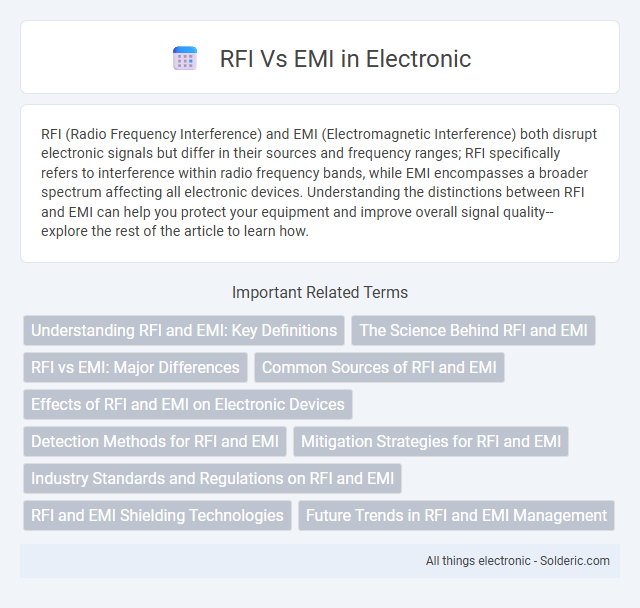RFI (Radio Frequency Interference) and EMI (Electromagnetic Interference) both disrupt electronic signals but differ in their sources and frequency ranges; RFI specifically refers to interference within radio frequency bands, while EMI encompasses a broader spectrum affecting all electronic devices. Understanding the distinctions between RFI and EMI can help you protect your equipment and improve overall signal quality--explore the rest of the article to learn how.
Comparison Table
| Aspect | RFI (Radio Frequency Interference) | EMI (Electromagnetic Interference) |
|---|---|---|
| Definition | Interference specifically from radio frequency signals | Interference from any electromagnetic source, including radio, magnetic, and electrical fields |
| Frequency Range | 3 kHz to 300 GHz (radio frequency spectrum) | Broad spectrum: from low-frequency magnetic fields to high-frequency radio waves |
| Common Sources | Broadcast transmitters, mobile phones, radar | Power lines, motors, radio transmitters, switching devices |
| Impact | Disrupts radio communications and wireless devices | Affects all electronic circuits and devices, causing malfunctions or data loss |
| Mitigation | Shielding, filtering, proper grounding of antenna systems | Electromagnetic shielding, circuit design, grounding, filtering |
Understanding RFI and EMI: Key Definitions
RFI (Radio Frequency Interference) and EMI (Electromagnetic Interference) are disturbances that affect electronic devices, where RFI specifically refers to interference caused by radio frequency signals, typically within the 3 kHz to 300 GHz spectrum. EMI encompasses a broader range of electromagnetic disturbances, including RFI, and can originate from natural or man-made sources such as electrical circuits, wireless communications, or lightning. Both RFI and EMI degrade the performance of electronic equipment by disrupting signal integrity and causing data loss or communication errors.
The Science Behind RFI and EMI
RFI (Radio Frequency Interference) and EMI (Electromagnetic Interference) originate from electromagnetic waves disrupting electronic devices. RFI specifically involves unwanted radio frequency signals causing noise or signal distortion in wireless communications, while EMI encompasses a broader spectrum of electromagnetic emissions affecting all types of electronic circuits. Both phenomena arise from sources like electrical circuits, power lines, and wireless transmitters, generating disturbances through electromagnetic coupling, radiation, or conduction.
RFI vs EMI: Major Differences
RFI (Radio Frequency Interference) and EMI (Electromagnetic Interference) differ primarily in their frequency ranges and sources; RFI specifically refers to interference in the radio frequency spectrum, typically from wireless communication devices, while EMI encompasses a broader range of electromagnetic disturbances, including radio waves, electric fields, and magnetic fields from various electronic devices. RFI usually affects radio and television signals, causing static or signal loss, whereas EMI can disrupt a wide array of electronic equipment, from medical devices to industrial machinery. Effective mitigation techniques vary, with RFI often addressed through shielding and filtering in radio equipment, while EMI requires comprehensive system design changes and grounding strategies to minimize its impact.
Common Sources of RFI and EMI
Common sources of RFI include wireless communication devices, radio transmitters, and broadcast stations that emit radio waves disrupting electronic equipment. EMI often originates from electrical motors, power lines, switching power supplies, and lightning strikes, causing unwanted electromagnetic disturbances. Understanding these sources helps you mitigate interference and ensure optimal device performance.
Effects of RFI and EMI on Electronic Devices
RFI (Radio Frequency Interference) and EMI (Electromagnetic Interference) can disrupt the normal operation of electronic devices by causing signal degradation, data loss, and malfunctions. RFI primarily affects wireless communication systems, leading to distorted transmissions and reduced device performance, while EMI can induce unwanted currents in circuits, potentially damaging sensitive components. Understanding these effects is crucial to protecting your devices through proper shielding and filtering techniques.
Detection Methods for RFI and EMI
Detection methods for RFI (Radio Frequency Interference) and EMI (Electromagnetic Interference) primarily involve spectrum analyzers, oscilloscopes, and EMI receivers to identify and measure unwanted electromagnetic signals. Directional antennas and near-field probes help isolate interference sources by capturing specific frequency ranges and spatial characteristics. Advanced techniques include time-domain analysis and correlation methods to differentiate between RFI, typically narrowband radio signals, and EMI, often broadband noise affecting electronic devices.
Mitigation Strategies for RFI and EMI
Mitigation strategies for RFI (Radio Frequency Interference) and EMI (Electromagnetic Interference) involve shielding techniques, such as using conductive enclosures and EMI gaskets to block unwanted signals. Implementing proper grounding and bonding reduces noise coupling, while installing filters like ferrite beads and EMI chokes helps suppress interference on cables. PCB layout optimization, including careful trace routing and separation of signal types, also plays a crucial role in minimizing RFI and EMI effects in electronic systems.
Industry Standards and Regulations on RFI and EMI
Industry standards and regulations on RFI (Radio Frequency Interference) and EMI (Electromagnetic Interference) are governed by organizations such as the FCC (Federal Communications Commission), IEC (International Electrotechnical Commission), and CISPR (International Special Committee on Radio Interference). Compliance with standards like CISPR 22, FCC Part 15, and IEC 61000 series ensures electronic devices minimize emissions and resistance to interference, safeguarding communication systems and electronic equipment performance. Manufacturers must conduct rigorous testing and certification processes to meet these regulatory requirements, preventing operational disruptions and ensuring legal market access.
RFI and EMI Shielding Technologies
RFI and EMI shielding technologies protect electronic devices by blocking unwanted radio frequency interference (RFI) and electromagnetic interference (EMI) that cause signal disruption and device malfunction. Common shielding materials include conductive metals like copper and aluminum, as well as advanced composites designed to absorb or reflect electromagnetic waves effectively. To safeguard your sensitive electronics, selecting the right combination of shielding enclosures, coatings, and gaskets tailored to specific RFI and EMI frequencies ensures optimal performance and reliability.
Future Trends in RFI and EMI Management
Emerging materials like metamaterials and nanocomposites enhance RFI and EMI shielding efficiency in compact electronic devices. Advanced AI algorithms enable real-time detection and adaptive mitigation of electromagnetic disturbances across complex network environments. Integration of 5G and IoT technologies drives the development of smarter, more resilient EMI management systems tailored for high-frequency applications.
RFI vs EMI Infographic

 solderic.com
solderic.com